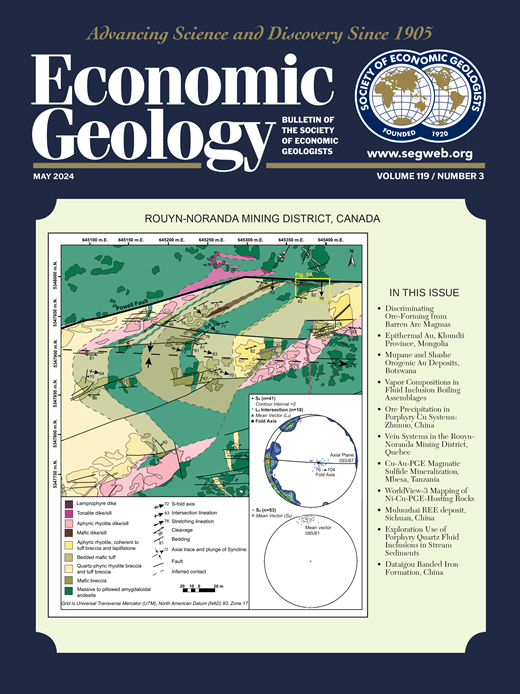新南威尔士州Cowal的GRE46浅成热液金矿:地质、成矿、蚀变和矿石成因
IF 4.9
1区 地球科学
Q1 GEOCHEMISTRY & GEOPHYSICS
引用次数: 0
摘要
2.74 Moz构造控制的浅成热液型GRE46金矿床位于澳大利亚新南威尔士州中部煤火成岩杂岩的西缘。在区域尺度上,煤岩杂岩位于暴露程度较差的六月—窄矿火山带南端,是构成奥陶系—早志留世麦格理弧的4条残余火山带的最西端。GRE46矿床位于一条4.5公里长的构造走廊的北端,该走廊由几个突出的弧形平行构造所界定。这条构造走廊还包含E40、E41和E42金矿床,开采前的黄金储备超过1400万盎司。GRE46矿床赋存于一套钙碱性至玄武质水下火山岩和火山碎屑岩中,形成于海内岩浆弧环境。寄主地层以改造后的火山沉积和非火山沉积为主,包括泥砂岩、卵石砾岩、多晶火山角砾岩和碎屑流。次级原生火山岩由序贯安山岩-英安岩流和闪长岩-花岗闪长岩脉和岩台组成,具有共同的透明碎屑岩和高辉长岩结构。GRE46金矿主要与毫米至厘米尺度的石英-碳酸盐-黄铁矿脉伴生,少量黄铜矿、方铅矿、闪锌矿和稀有碲化物矿物伴生。矿化矿脉类型多样,包括复合型和带状扩张矿脉、剪切矿脉、弦状矿脉和高品位石英硫化物角砾岩矿脉。寄主岩石受到不同程度的热液蚀变,蚀变的样式和强度受邻近控流构造和原岩组成的影响。金的最高品位与普遍存在的石英+白云母+铁白云石+黄铁矿蚀变密切相关,并叠加绿泥石+钠长石+方解石±磁铁矿蚀变。在矿床尺度上,金矿化受原有构造的强烈影响,导致在火山-沉积地层包体能力对比形成的渗透率增强带中存在非均质热液流动。GRE46可归类为与侵入体有关的浅成热液型金矿化。矿床的矿石和脉石矿物学、伴生脉纹的样式和结构、蚀变组合等特征与中硫化模式和碳酸盐基金属浅成热液模式基本一致。本文章由计算机程序翻译,如有差异,请以英文原文为准。
The GRE46 Epithermal Gold Deposit, Cowal, New South Wales: Geology, Mineralization, Alteration, and Ore Genesis
The 2.74 Moz structurally controlled epithermal GRE46 gold deposit is located on the western margin of the Cowal Igneous Complex in central New South Wales, Australia. At the regional scale, the Cowal Igneous Complex is located toward the southern end of the poorly exposed Junee-Narromine volcanic belt, the westernmost of four remnant volcanic belts that together constitute the Ordovician to early Silurian Macquarie arc. The GRE46 deposit is located at the northern end of a 4.5-km-long structural corridor that is defined by several prominent arc-parallel structures. This structural corridor also contains the E40, E41, and E42 gold deposits, and has a collective pre-mining gold endowment of over 14 Moz. The GRE46 deposit is hosted in a sequence of calc-alkalic to shoshonitic subaqueous volcanic and volcaniclastic rocks, interpreted to have formed in an intra-oceanic magmatic arc environment. The host stratigraphy is dominated by reworked volcanic deposits and nonvolcanic sedimentary deposits that include mud- to sandstones, pebble to cobble conglomerates and polymictic volcanic breccias and debris flows. Lesser primary volcanic rocks consist of coherent andesite to dacite flows with common hyaloclastite and peperite textures, and diorite to granodiorite dikes and sills. Gold mineralization at GRE46 occurs primarily in association with millimeter- to centimeter-scale quartz-carbonate-pyrite veins, with minor chalcopyrite, galena, sphalerite, and rare telluride minerals. Multiple styles of mineralized veins are present, including composite and banded dilatant veins, shear veins, stringer veins, and high-grade quartz-sulfide breccia veins. The host rocks were variably hydrothermally altered, with the style and intensity of alteration influenced by proximity to fluid-flow controlling structures and protolith compositions. The highest gold grades are closely associated with pervasive quartz + white mica + ankerite + pyrite alteration that overprinted chlorite + albite + calcite ± magnetite alteration. At the deposit scale, gold mineralization was strongly influenced by the pre-existing structural architecture, leading to heterogeneous hydrothermal fluid flow in zones of enhanced permeability that were created due to competency contrasts in the volcano-sedimentary stratigraphic package. GRE46 can be classified as an intrusion-related epithermal style of gold mineralization. The deposit has several characteristics, including the ore and gangue mineralogy, style and textures of associated veining, and the alteration assemblage, which are broadly consistent with both the intermediate sulfidation and the carbonate-base metal epithermal models.
求助全文
通过发布文献求助,成功后即可免费获取论文全文。
去求助
来源期刊

Economic Geology
地学-地球化学与地球物理
CiteScore
10.00
自引率
6.90%
发文量
120
审稿时长
6 months
期刊介绍:
The journal, now published semi-quarterly, was first published in 1905 by the Economic Geology Publishing Company (PUBCO), a not-for-profit company established for the purpose of publishing a periodical devoted to economic geology. On the founding of SEG in 1920, a cooperative arrangement between PUBCO and SEG made the journal the official organ of the Society, and PUBCO agreed to carry the Society''s name on the front cover under the heading "Bulletin of the Society of Economic Geologists". PUBCO and SEG continued to operate as cooperating but separate entities until 2001, when the Board of Directors of PUBCO and the Council of SEG, by unanimous consent, approved a formal agreement of merger. The former activities of the PUBCO Board of Directors are now carried out by a Publications Board, a new self-governing unit within SEG.
 求助内容:
求助内容: 应助结果提醒方式:
应助结果提醒方式:


